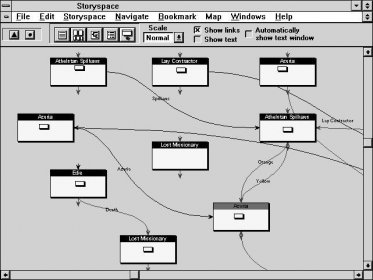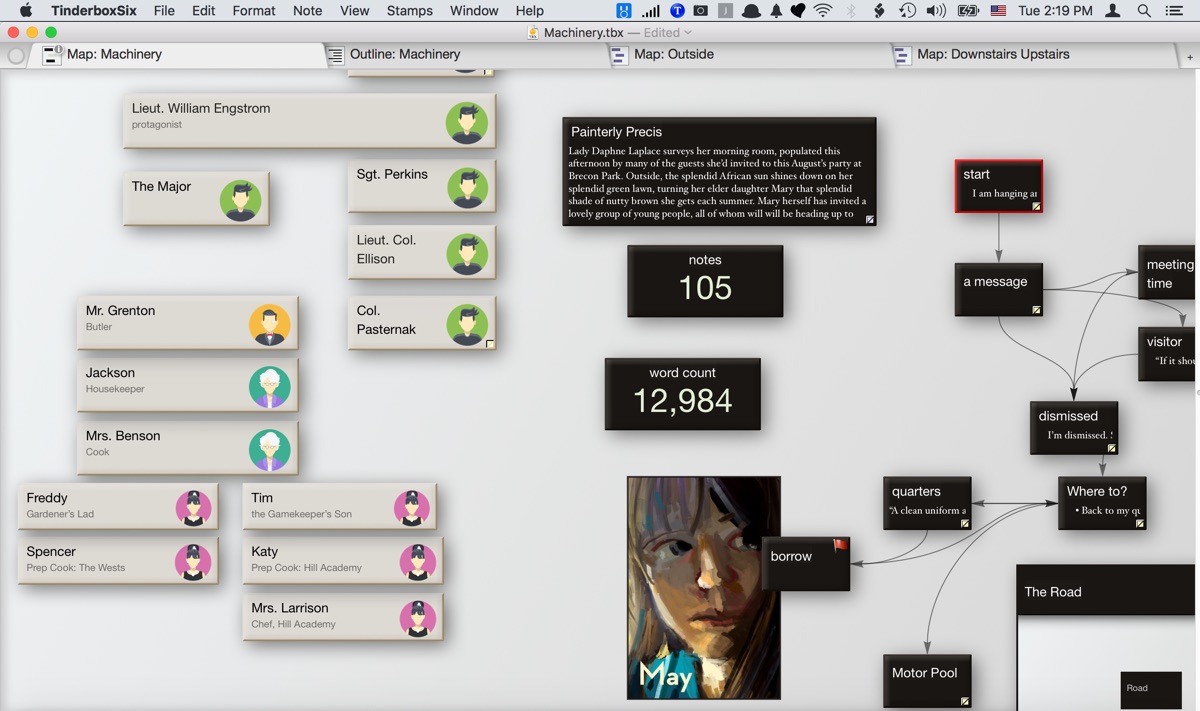There aren’t many apps still around and thriving which can claim to be the first of their kind: pieces not just of computer history but of our cultural history too. Eastgate Systems’ Storyspace is the only such app which springs to my mind.
Back in the 1980s, which I realise is around thirty years ago, and before many of you were born, hypertext was the VR of the day. Originally conceived in 1963 by author Ted Nelson, it was first realised in a demonstration computer system by Douglas Engelbart in 1968. Tim Berners-Lee and others then developed early hypertext-based systems which evolved into the World Wide Web, and so the first HyperText Markup Language (HTML) was coined. Mac users were able to explore hypertext concepts when Apple released HyperCard in 1987.
Storyspace was the first software program specifically developed for creating, editing, and reading hypertext fiction. It was created in the 1980s by Jay David Bolter and Michael Joyce, who presented it to the first international meeting on Hypertext at Chapel Hill in October 1987. Several classics of hypertext literature were created using Storyspace, such as Afternoon, a story by Michael. Site: Braddock PA. Context: This space allows context to be the main driver of form. Research led to identifying economic, sociologic, demographic forces among others that affect the site and community. Once identified, these forces were converted into a 2D abstract graphic through contextual mapping.
Salamanders loll in the wading place. Squiggle under weeds but I can still see. Raise my aching eyes and fill up with the maple buds dottering the sky. And the laid back sun gazing down side where the salamanders sleep in the dusky dark weed deep in space.
At roughly the same time, in 1987, Jay David Bolter and Michael Joyce, with John B Smith, presented their hypertext authoring and reading environment intended primarily for fiction, Storyspace, to the first international meeting on hypertext, ACM Hypertext 1987. Four years later, it was taken forward by Eastgate Systems and Mark Bernstein.


Now, after 28 years, I am delighted – and deeply so – that Eastgate Systems has just released version 3, which runs a treat on OS X 10.11, El Capitan. I am equally sorry that Apple did not see fit to ensure that HyperCard was here to accompany it.
Some of the great works of hypertext literature have been created using Storyscape – Michael Joyce’s afternoon, a story, Stuart Moulthrop’s Victory Garden, and Shelley Jackson’s Patchwork Girl. These and other works are available from Eastgate’s online shop.
Storyspace integrates strongly with Eastgate’s sister product, Tinderbox, a note-making environment which is as mature. I used to use Tinderbox quite a bit, but superb though it is, it dropped out of my workflow some years ago. The last time that I can recall using Storyspace is almost ten years ago, as the screenshot above demonstrates; it was taken of the monumental hypertext book, In Memoriam Web, about Tennyson and the Victorians, which then blossomed into The Victorian Web, on the web.
I have not yet had a chance to explore Storyspace 3 in any detail, but as a test of its robustness, I imported a very large (7.9 MB) Tinderbox reference to the features of Tinderbox (aTbRef). This is a far cry from fiction, and was never intended to appear in Storyspace, but must count as a pretty good stress test.
Version 3 has a thoroughly modern interface which makes excellent use of large displays. There are six different views of the hypertext structure, which are shown in the following screenshots: Map, Outline, Chart, Attributes, Timeline, and Treemap.
Hypertext in Storyspace is much more than the simple links you have experienced in HTML. One of the fundamental differences is the presence of Guard Fields on links. These are tests applied to determine whether a given link can be followed at this reading. In previous versions, these might include conditions such as which writing spaces (each node or page of content) had been visited previously, and those have been extended in version 3.

Storyspaces Inc
This version also introduces what Mark Bernstein refers to as sculptural hypertext, which begins by connecting a group of writing spaces together, then establishes constraints in their reading order.
So far, Storyspace’s model of hypertext has been criticised as being too complex for the creation of hypertext works, but the many books available from Eastgate attest otherwise. We have also become much more accustomed to non-linear structures in blogs and other websites.
Perhaps the most important steps are those yet to come. A superb authoring environment is only of use if readers can access Storyspace documents. Eastgate promises us a redistributable standalone reader for OS X shortly, and even more exciting is the following iPad reader, and support for Windows. Storyspace 3 can export to HTML for publication on websites, but I suspect will lose some of its richness in doing so.
As I explore Storyspace more in the coming months, I will post periodic updates here, hopefully with some examples to try using its forthcoming reader apps. Watch this Storyspace…
A Story About Space

Storyspace
Storyspace 3.0.0 for OS X is $149 from Eastgate Systems. You can download a demo from here. If you still have a licence for an old version, Eastgate will be delighted to upgrade it for a mere $77.
